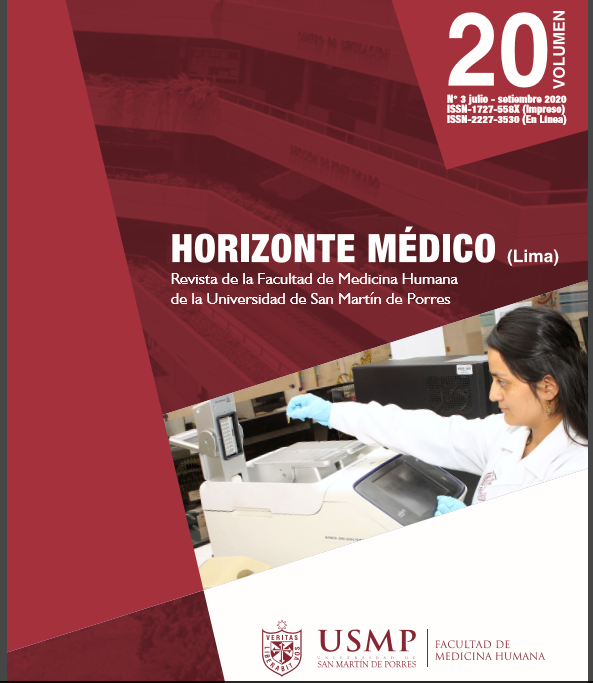Definiciones, criterios diagnósticos y valoración de terminalidad en enfermedades crónicas oncológicas y no oncológicas
DOI:
https://doi.org/10.24265/horizmed.2020.v20n3.11Palabras clave:
Enfermedad crónica, Cuidado terminal, Cuidados paliativos, PronósticoResumen
Los cambios demográficos mundiales han producido nuevos retos en el sistema de salud. La atención de pacientes de mayor edad y con problemas de salud más complejos se ha incrementado de manera importante y sobrepasan nuestra capacidad de respuesta; el Perú no escapa a esta realidad. Estos pacientes necesitan cada vez mayores cuidados y la enfermedad crónica en fase avanzada requiere un cambio de enfoque; de los tratamientos agresivos con fines curativos hacia un enfoque paliativo, de mejora de la calidad de vida, asociado a un importante contenido social. La enfermedad en fase terminal se sitúa en la etapa final de la vida, en la que existe daño irreversible y múltiples síntomas somáticos, psicológicos y espirituales, con gran impacto en el paciente y su familia. Se ha estudiado con relativa frecuencia la enfermedad oncológica en fase terminal, sin embargo, las no oncológicas tienen mayor frecuencia y sobrevida. El objetivo de la presente revisión es hacer un compendio de las definiciones operacionales de esta condición, describir criterios diagnósticos específicos de terminalidad, resumir instrumentos para identificar necesidad de cuidados paliativos y escalas de pronóstico publicadas en la literatura científica.
Descargas
Citas
Connor SR, Sepulveda Bermedo MC. Global atlas of palliative care at the end of life. London: Worldwide Hospice Palliative Care Alliance. 2014. Disponible en: https://www.who.int/nmh/ Global_Atlas_of_Palliative_Care.pdf
Salas Campo T, Vicente Sánchez F, Valentín Maganto V, de Miguel Sánchez C, Sanz Llorente B, Lacasta Reverte A, et al. Guía de cuidados paliativos de la comunidad de Madrid. Madrid. 2008. Disponible en: https://www.bioeticaweb.com/wp-content/ uploads/2014/07/guia_paliativos.pdf
Pastrana T, De Lima L, Wenk R, Eisenchlos J, Monti C, Rocafort J, et al. Atlas de cuidados paliativos en Latinoamérica [libro electrónico]. Houston: IAHPC Press. 2012. Disponible en: https:// cuidadospaliativos.org/uploads/2012/10/atlas/Atlas%20de%20 Cuidados%20Paliativos%20en%20Latinoamerica.pdf.
Amado JP, Vasquez R, Huari RW, Sucari A, Oscanoa T. Patients with end-stage oncologic and non-oncologic disease in emergency service of an Urban Tertiary Hospital. Indian J Palliat Care. 2018; 24(1): 25-7.
Le Conte P, Riochet D, Batard E, Volteau C, Giraudeau B, Arnaudet I, et al. Death in emergency departments: a multicenter cross
sectional survey with analysis of withholding and withdrawing life support. Intensive Care Med. 2010; 36(5): 765-72.
Rosenwax LK, McNamara BA, Murray K, Mccabe RJ, Aoun SM, Currow DC. Hospital and emergency department use in the last year of life: a baseline for future modifications to end-of-life care. Med J Aust. 2011; 194(11): 570-3.
Henson LA, Gao W, Higginson IJ, Smith M, Davies JM, Ellis-Smith C, et al. Emergency department attendance by patients with cancer in their last month of life: a systematic review and meta-analysis. J Clin Oncol. 2015; 33(4): 370-6.
Callahan D. Death and the research imperative. N Engl J Med. 2000; 342(9): 654-6.
Alonso JP. Cuidados paliativos: entre la humanización y la medicalización del final de la vida. Cien Saúde Coletiva. 2013; 18(9): 2541-8.
Navarro Sanz R, Valls Roig M, Castellano Vela E. Atención a pacientes crónicos avanzados no oncológicos con necesidad de cuidados al final de la vida en un hospital de media y larga estancia. Medicina Paliativa. 2011; 18(2): 54-62.
Sánchez Isac M. Factores pronósticos de terminalidad no oncológica en cuidados paliativos [Tesis]. Madrid: Universidad Complutense de Madrid. Facultad de Medicina; 2013.
Babarro AA, Cano LR, Aguilar AG. Criterios de selección de pacientes con enfermedades no oncológicas en programas y/o servicios de cuidados paliativos. Medicina Paliativa. 2010; 17(3): 161-71.
Sociedad Española de Cuidados Paliativos (SECPAL). Guía de cuidados paliativos [internet]. 2014. Disponible en: https:// cmvinalo.webs.ull.es/docencia/Posgrado/8-CANCER Y CUIDADOSPALIATIVOS/guiacp.pdf
McEwan A, Silverberg JZ. Palliative care in the emergency department. Emerg Med Clin North Am. 2016; 34(3): 667-85.
Walsh RI, Mitchell G, Francis L, van Driel ML. What diagnostic tools exist for the early identification of palliative care patients in general practice? A systematic review. J Palliat Care. 2015; 31(2): 118-23.
Iglesias ML, Lafuente A. Asistencia al paciente agónico que va a fallecer en urgencias. Anales Sis San Navarra. 2010; 33(Suppl.1): 173-91.
Australasian College for Emergency Medicine. Policy on end of life and palliative care in the emergency department (P455). Emerg Med Australas. 2016; 28(5): 617-21.
Rosenberg JP, Bullen T, Maher K. Supporting family caregivers with palliative symptom management: a qualitative analysis of the provision of an emergency medication kit in the home setting. Am J Hosp Palliat Med. 2015; 32(5): 484-9.
Richards CT, Gisondi MA, Chang CH, Courtney DM, Engel KG, Emanuel L, et al. Palliative care symptom assessment for patients with cancer in the emergency department: validation of the screen for palliative and end-of-life care needs in the emergency department instrument. J Palliat Med. 2011; 14(6): 757-64.
Bernabeu-Wittel M, Murcia-Zaragoza J, Hernández-Quiles C, Escolano-Fernández B, Jarava-Rol G, Oliver M, et al. Development of a six-month prognostic index in patients with advanced chronic medical conditions: the PALIAR score. J Pain Symptom Manage. 2014; 47(3): 551-65.
Ouchi K, Wu M, Medairos R, Grudzen CR, Balsells H, Marcus D, et al. Initiating palliative care consults for advanced dementia patients in the emergency department. J Palliat Med. 2014; 17(3): 346-50.
Metola Gómez A, García Romo E, Bellido de Vega S, Carretero Lanchas Y, Azcoitia Álvarez B, Guerrero L. Análisis de la evolución de pacientes en probable situación de últimos días en un servicio de urgencias. Medicina Paliativa. 2013; 20(1): 10-8.
Kao YH, Chiang JK. Effect of hospice care on quality indicators of end-of-life care among patients with liver cancer: a national longitudinal population-based study in Taiwan 2000-2011. BMC Palliat Care. 2015; 14: 39.
Gómez-Batiste X, Martínez-Muñoz M, Blay C, Amblàs J, Vila L, Costa X, et al. Identifying patients with chronic conditions in need of palliative care in the general population: development of the NECPAL tool and preliminary prevalence rates in Catalonia. BMJ Support Palliat Care. 2013; 3(3): 300-8.
Thomas K. Prognostic Indicator Guidance (PIG): the gold standards framework centre in end of life care cic [internet]. 4th edition. London. 2011. Disponible en: https://www. goldstandardsframework.org.uk/cd-content/uploads/files/ General Files/Prognostic Indicator Guidance October 2011.pdf
Thomas K, Wilson JA, GSF Team. Prognostic indicator guidance (PIG), national gold standards framework centre in end of life care [Internet]. 6th Edition. 2016. Disponible en: http://www. goldstandardsframework.org.uk
Fachado AA, Martínez NS, Roselló MM, Ria JJV, Oliver EB, García RG, et al. Spanish adaptation and validation of the supportive & palliative care indicators tool - SPICT-ESTM. Rev Saúde Pública. 2018; 52: 3.
Australian Commission on Safety and Quality in Health Care. National consensus statement: essential elements for safe and high-quality end-of-life care. Sydney: ACSQHC. 2015. Disponible en: https://www.safetyandquality.gov.au/wp-content/ uploads/2015/05/National-Consensus-Statement-EssentialElements-forsafe-high-quality-end-of-life-care.pdf
Vila Arias JM, Pereira Santelesforo S, Lopez Alvarez E, Mendez Muñoz M, Guzmán Gutierrez J, Sanmartín Moreira J. Utilidad del palliative performance scale v2 para la estimación de supervivencia en enfermos con cáncer avanzado. Medicina Paliativa. 2012; 19(4): 133-8.
Ho F, Lau F, Downing MG, Lesperance M. A reliability and validity study of the palliative performance scale. BMC Palliat Care. 2008; 7: 10.
Forcano García M, Quilez Salas N, Vial Escolano R, Solsona Fernández S, González García P. Predicción de supervivencia en el paciente con cáncer avanzado. Medicina Paliativa. 2015; 22(3): 106-16.
Scarpi E, Maltoni M, Miceli R, Mariani L, Caraceni A, Amadori D, et al. Survival prediction for terminally Ill cancer patients: revision of the palliative prognostic score with incorporation of delirium. Oncologist. 2011; 16(12): 1793-9.
Nieto Martín MD, Bernabeu Wittel M, de la Higuera Vila L, Mora Rufete A, Barón Franco B, Ollero Baturone M, et al. Adaptation of the palliative prognostic index in patients with advanced medical conditions. Rev Clin Esp. 2013; 213(7): 323-9.
Chuang RB, Hu WY, Chiu TY, Chen CY. Prediction of survival in terminal cancer patients in Taiwan: constructing a prognostic scale. J Pain Symptom Manage. 2004; 28(2): 115-22.
Gwilliam B, Keeley V, Todd C, Gittins M, Roberts C, Kelly L, et al. Development of Prognosis in Palliative Care Study (PiPS) predictor models to improve prognostication in advanced cancer: prospective cohort study. BMJ. 2011; 343: d4920.
Kalpakidou AK, Todd C, Keeley V, Griffiths J, Spencer K, Vickerstaff V, et al. The Prognosis in Palliative Care Study II (PiPS2): study protocol for a multi-centre, prospective, observational, cohort study. BMC Palliat Care. 2018; 17(1): 101.
Na HR, Kim SY, Chang YH, Park MH, Cho ST, Han IW, et al. Functional assessment staging (FAST) in korean patients with Alzheimer’s disease. J Alzheimers Dis. 2010; 22(1): 151-8.
Powrie D. The BODE index: a new grading system in COPD. Thorax. 2004; 59(5): 427.
Celli BR, Cote CG, Marin JM, Casanova C, Montes de Oca M, Mendez RA, et al. The body-mass index, airflow obstruction, dyspnea, and exercise capacity index in chronic obstructive pulmonary disease. N Engl J Med. 2004; 350(10): 1005-12.
Hernández Quiles C, Bernabeu Wittel M, Praena Segovia J, Ternero Vega J, Díez Manglano J, Jarava Rol G, et al. Comparación de la pregunta sorpresa frente a un índice objetivo (Índice PALIAR) para la identificación de situación terminal en pacientes con enfermedades crónicas avanzadas. Rev Clin Esp. 2017; 217(2): 123-4.
##submission.downloads##
Publicado
Cómo citar
Número
Sección
Licencia
Derechos de autor 2020 José Amado, Teodoro Oscanoa

Esta obra está bajo una licencia internacional Creative Commons Atribución 4.0.
El contenido de la Revista Horizonte Médico es de libre acceso, de manera gratuita, con el fin de divulgar los trabajos y experiencias desarrolladas en el área biomédica y de salud pública realizados a nivel nacional e internacional, promoviendo la investigación en los diferentes campos de la medicina humana.
La Revista Horizonte Médico mantiene los derechos de autoría, distribución y reproducción de los artículos publicados.
Todos los artículos aceptados y publicados en la Revista Horizonte Médico se distribuyen gratuitamente bajo los términos de la licencia Creative Commons Attribution 4.0 International (CC BY 4.0).

















